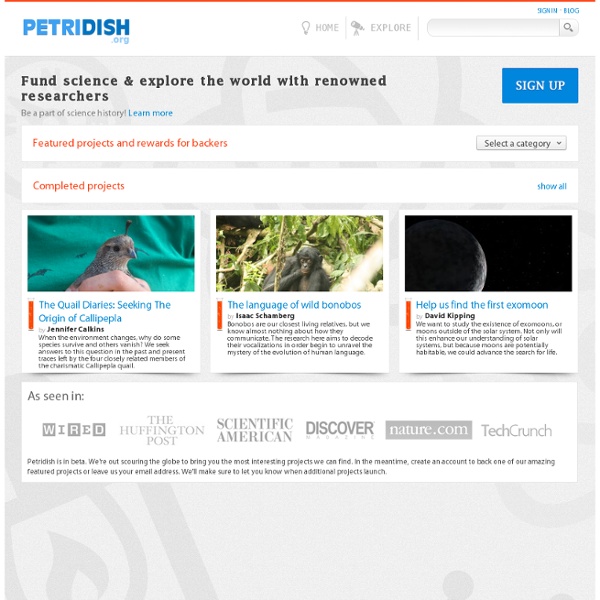



Site Inovação Tecnológica - Tudo o que acontece na fronteira do conhecimento Real-time web analytics with Clicky Clicky clicky on the wall, who’s the best real-time analytics of them all? It’s not a hard question to answer. You should be using Clicky. Sure, Google Analytics has a real-time view of visitors on your site and what they’re doing, but it’s not exactly the best experience or easiest to understand. Since most analytics don’t let you see what’s happening today until the day after, it can be difficult to see how your marketing efforts are effecting people in real time. So let’s say you spent 10 hours on a thought provoking article and tweet it or submit it to digg.com. You then sit there... and wait for the next day to check for visits, link backs, and interactions. With Clicky, you get real-time data that lets you react to changes in your traffic as they occur. So if your article hit the front page of a popular site like digg.com, you would see the traffic spike in Clicky immediately, along with links back to the sources sending you the traffic. You can also do one-click segmentation. P.S.
Gambitious Digital Designs for Physical Objects Days Remaining: 0 Could you live on Mars? Certainly not without great design and engineering. That's why we, in cooperation with NASA's Jet Propulsion Laboratory, are excited to present the Makerbot Mars Base Challenge. Learn more about Mars and what kind of home could actually sustain life there on {*style:<a href=' Imagine Mars website{*style:</a>*}.Upload your design to Thingiverse with the tag #MakerBotMars between May 30th and June 12th.
republic wireless - a community of people “Works Like a Charm” Submitted by brian on Tue, 12/06/2011 – 1:03am As you may have seen, the initial reviews of republic wireless are coming in. We’re glad to read that professional testers and many of our earliest members appreciate the technology and that it’s working for them. Of course, we always can and want to make it even better, and we are. Equally, while the product technology "works like a charm" (in many ways, at least, especially this early in its life), we know very well that republic is not yet serving you the way that we want to. Either way, we thank you for your support! By way of update, since my previous post we have directed our efforts to the following main areas: Our progress in some of these areas is obvious, while in others it remains in the background. An Example: Numbers The process of issuing phone numbers is a great example of this dynamic. That’s a good indicator of the kind of company we are. What’s Next Hiring!
FingerReader Roy Shilkrot, Jochen Huber, Meng Ee Wong, Pattie Maes, and Suranga Chandima Nanayakkara. "FingerReader: a wearable device to explore text reading on the go". To appear in the proceedings of the International Conference on Human Factors in Computing Systems (CHI). 2015 ACM [PDF] Roy Shilkrot, Jochen Huber, Connie K. Roy Shilkrot, Jochen Huber, Connie K. Ting - Mobile That Makes Sense The Social Lab Rose Park Advisors - Home News Challenge - Home epicshirtmakers Design | WarkaWater Inspiration The Warka’s water harvesting technique and construction system are inspired by several sources. Many plants and animals have developed unique micro- and nano-scale structural features on their surfaces that enable them to collect water from the air and survive in hostile environments. By studying the Namib beetle’s shell, lotus flower leaves, spider web threads and the integrated fog collection system in cactus, we are identifying specific materials and coatings that can enhance dew condensation and water flow and storage capabilities of the mesh. The termite hives have influenced the design of Warka’s outer shell, its airflow, shape and geometry. We also looked at local cultures and vernacular architecture, incorporating traditional Ethiopian basket-weaving techniques in Warka’s design. Front View Top View How it Works The external skeleton consists of bamboo and provides structural support and holds up the mesh, collector and canopy. Characteristics Materials Elements Modularity
Assistants for Everyone - Fancy Hands Kairos T-band Smartwatch: Best of analog-digital | Indiegogo Watches express who you are. Kairos T-band allows you to wear your favorite wristwatch while enjoying all the benefits a smartwatch can bring. Smartwatches and wearable devices (smart bands) are here to stay. It began as a simple notification extension of your smart phone. It evolved into counting your steps, calories, and sleep patterns. We are now seeing more and more app support where you can control music, turn speech to text, GPS navigation, and also remote starting your vehicle. "Watches are more than just an accessory that tells time. It holds sentimental value. It’s an asset – something you hold onto and possibly pass on. T-band. T-band ND / HD / OD: There are three models of the T-band. T-Band ND (No Display): (* T-band ND shown with KAIROS MSW 115M model) Features: On board Kairos OS will be able to push notifications such as text messages, incoming calls, and also push alerts from available apps via a discreet multi-color LED indicator and/or vibrator motor. The Perks: Light.